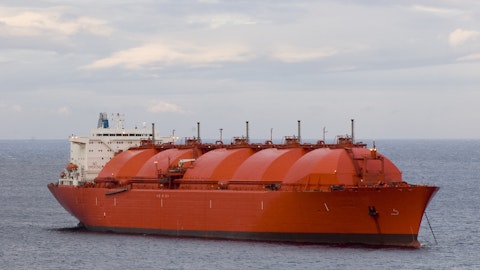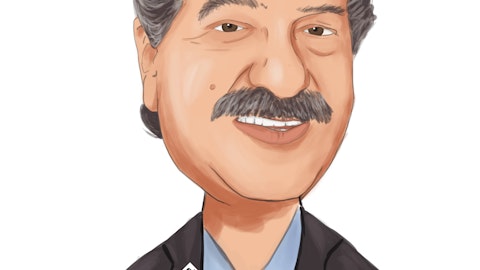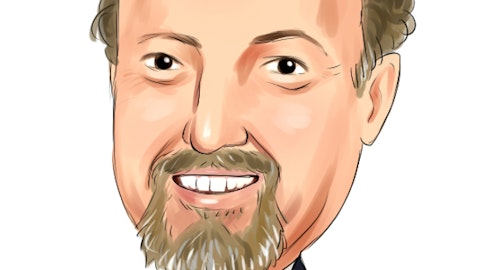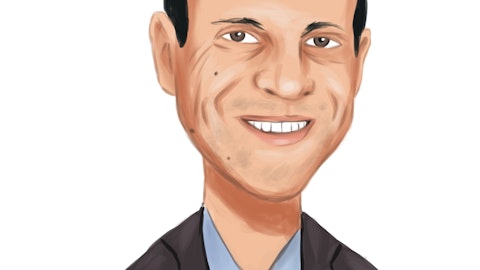Excelerate Energy, Inc. (NYSE:EE) Q3 2022 Earnings Call Transcript November 10, 2022
Excelerate Energy, Inc. beats earnings expectations. Reported EPS is $1.46, expectations were $0.29.
Operator: Hello, everyone, and welcome to the Excelerate Energy 3Q 2022 earnings call. My name is Drew, and I’ll be coordinating your call today. . I would now like to turn the call over to Craig Hicks, Vice President, Investor Relations. Please go ahead.
Craig Hicks: Thank you, and good morning, everyone. Yesterday afternoon, we released our third quarter earnings press release, along with the presentation that our President and Chief Executive Officer, Steven Kobos; and our Chief Financial Officer, Dana Armstrong, will speak to you this morning. I would like to remind everyone that we will be making forward-looking statements on this call that involve a number of risks and uncertainties. Our actual results may differ materially from those expressed in these forward-looking statements, and we make no obligation to update or revise them. Also, during the call, we’ll also discuss several non-GAAP financial measures. We’ve provided a reconciliation to the most directly comparable GAAP financial measures at the back of the presentation. And with that, it’s my pleasure to pass the call over to Steven Kobos.
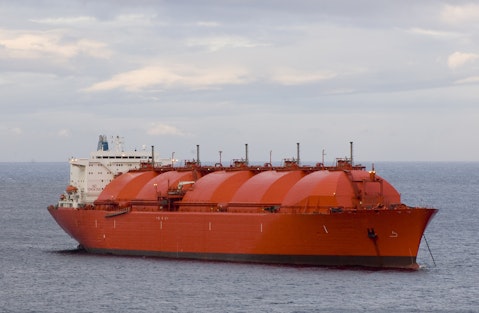
Oleksandr Kalinichenko / Shutterstock.com
Steven Kobos: Hi, there. Thanks, Craig, and thank you all for joining us this morning. Excelerate delivered another strong quarter of financial results, as we continue to advance our growth strategy and make good progress on our commercial opportunities. Against the backdrop of the most significant energy market disruption since the 1970s, we’ve seen the true value of Excelerate’s flexible business model, which enables us to adapt our asset portfolio to deliver optimal solutions that scale with our customers’ needs. Through the quarter, we demonstrated once again our ability to navigate successfully the complexity of today’s global LNG market. We are expanding our reach in both new and existing markets by pursuing attractive growth opportunities and deploying our flexible LNG infrastructure.
In our short time as a public company, we’ve rebalanced our commercial portfolio to address increasing LNG demand and energy security concerns in Europe. Our fleet flexibility has also allowed us to capture economic upside from elevated FSRU charter rates, while we continue to position our gas sales business for growth and increased profitability over the long term. On this morning’s call, I’ll focus my remarks on our third quarter financial results, the current state of the global LNG market, and progress on our commercial opportunities. Dana will then walk through the details of our quarterly performance and our 2022 financial outlook, before we open the call to your questions. With that, now let’s turn to our results and highlights for the quarter.
Our financial performance during the third quarter was strong. We delivered $39 million of adjusted net income, and $86 million of adjusted EBITDA. Our bottom-line results during the quarter were driven primarily by another solid contribution from our regasification business, and our gas sales business in Brazil. On the commercial front, the deployment of the FSRU Exemplar to Finland remains on track, and our charter hire for the vessel commenced on October 1. We also signed a five-year time charter contract with Germany for the FSRU Excelsior. The Finland and Germany opportunities are great examples of how we’ve been able to redeploy seamlessly our assets to maximize our revenue. This ability to transition from on hire to technical stop to back on hire again in this manner, is unprecedented in our industry.
I’ll also highlight that on October 3, we executed our shipbuilding contract with Hyundai Heavy Industries, or HHI, for our new state-of-the-art FSRU, which will be delivered in June 2026. Next, as we approach the end of our first year selling gas downstream in Brazil, we are pleased that our gas sales business is proving to be as valuable as planned. We look forward to continuing to sell regasified LNG in Brazil in the future. We are finalizing agreement with Petrobras to extend our gas sales operations there through the end of 2023, and we are waiting final approvals. On August 31, the FSRU Exemplar completed its seasonal regasification charter at the Bahia Blanca GasPort in Argentina. During this period, the Exemplar regasified 12 LNG cargos, and provided energy security to Argentina during the Southern Hemisphere winter season.
And this week, on November 8, the Excelerate Board Of Directors declared our second quarterly dividend as a public company. Now I’d like to share with you some perspectives on the current state of the global LNG market. Since our last earnings call in August, we have continued to see robust demand for flexible LNG infrastructure around the world as countries seek energy security and independence. In Europe, countries are bracing for winter, and while they have succeeded in filling natural gas storage capacity to over 90%, the supply outlook for the 2023, 2024 heating season remains a concern. The September shutdown of, and subsequent damage to, the Nord Stream I and II pipelines, cut off critical natural gas supplies to Europe, and further intensified supply pressures In real time, we’ve watched the situation that could have been solved, politically evolve into one that now must be fixed with deployment of new infrastructure.
The ongoing curtailment of Russian flows, combined with increased natural gas storage injections heading into the winter season, has led to increased LNG imports to Europe. The resulting increasing competition between OECD and non-OECD countries for finite LNG supply, has exacerbated an already tight market. While gas – TTF gas pricing has come down since the peak, it is expected to remain at elevated levels relative to history. This means that any additional supply disruptions, or colder than expected weather, could cause significant short-term spikes. The combination of European onshore storage levels being near capacity, increased LNG imports, and mild fall weather have resulted in a buildup of latent LNG vessels around Europe. LNG tankers off the coast of Europe are awaiting opportunities to offload cargos at fully utilized regasification facilities.
This highlights the need for FSRUs and regasification infrastructure. The increased demand for FSRUs and LNG in Europe, is also influencing energy policy globally. Some countries, particularly those in Southeast Asia, have chosen to reduce LNG consumption in the near-term as a direct result of elevated pricing in the spot market. However, because LNG remains an important part of their future energy mix, they’re continuing to seek long-term affordable LNG supply to meet their energy needs. We are confident that these countries, with the support and backing from international organizations, will be able to achieve this objective. And while affordability and security of supply remain at the forefront in Europe, decarbonization remains a priority, now more than ever.
It is clear that natural gas will continue to play an important role in the energy transition, serving as a complementary backstop to balance the intermittency of renewable energy. We believe that FSRUs are the most important asset class to support Europe’s efforts to achieve energy security and transition to renewable energy sources without the risk of having stranded infrastructure over the long-term. Now, I’d like to take a moment to provide you with some important commercial updates. As I mentioned on our last call, we reached an agreement with the government of Finland for the Exemplar to provide up to 5 billion cubic meters per year of regasified LNG capacity through a new regasification terminal in southern Finland. This flexible LNG terminal will bolster the energy security of Finland, while also serving more broadly the needs of the Baltic Sea region.
Although the Exemplar is currently undergoing customer requested winterization upgrades during a technical stop in Spain, our charter hire with Gasgrid Finland commenced on October 1. Gasgrid. Finland, by the way, has done an exceptional job developing the tunnel facility, and the Exemplar should begin regasification operations at the Port of Inkoo, Finland, in December 2022. We’re also moving forward with our plans to sell regasified LNG downstream of the terminal. We’ve established a gas marketing entity in Finland, opened a new office near Helsinki, and our commercial team is actively pursuing near-term gas sale opportunities. Next, we have our agreement with Germany. We’ve executed a definitive agreement with the German government to charter the FSRU Excelsior for five years.
This is our second FSRU deployment to Europe since the invasion of Ukraine by Russia, and it demonstrates the ability of our business and our fleet to pivot quickly to capture new commercial opportunities. The Excelsior will complete its charter in Israel at the end of this year, and will go directly to its scheduled dry dock. Under the terms of the agreement with the German government, the Excelsior will commence its charter hire in the first quarter of 2023. The vessel is expected to provide regasification services in Germany’s planned LNG import terminal, which is being developed at the Port of Wilhelmshaven by Tree Energy Solutions, E.ON, and ENGIE. Now, let’s turn to Southern Europe. We believe that there is a tremendous opportunity to sell regasified LNG to customers in southern Europe downstream of our planned Vlora terminal.
Last quarter, we expanded the scope of our Albania project to include potential gas sales to countries linked to Europe’s southern gas corridor, including Italy, Greece, Bulgaria, and Turkey. Since then, the energy conflict between Europe and Russia has worsened. The damage to the Nor Stream pipelines has made the southern corridor as an entry point for LNG deliveries even more critical for Europe, and our planned Vlora terminal is even more valuable, since it will add incremental capacity and alternative supply in the event of further disruptions. In recent weeks, we’ve engaged with third parties for the engineering design for both the 300-megawatt power plant and the LNG terminal in Vlora. While we’re advancing the Vlora LNG terminal towards FID, we are also evaluating other downstream opportunities that would allow us to connect to existing natural gas pipelines in the region.
We’re excited about our prospects, and we’ll provide more detail on these opportunities as they progress. Now, let’s turn to Bangladesh. LNG remains critical to the country’s economy. Our two FSRU terminals currently deliver approximately 20% of Bangladesh’s natural gas supply. The government shares our view that long-term LNG supply will be a central part of its energy mix moving forward, and the country’s advancing plans to sign new long-term LNG supply agreements to guarantee more affordable and predictable LNG pricing. As discussed last quarter, rapid economic growth in Southwest Bangladesh is expected to drive increased energy demand in the region, and greater need for regasified LNG as a fuel source. We have recently completed our negotiations with Petrobangla for an LNG Sale and Purchase Agreement, or SPA, and are now waiting formal approvals.
We’ve also continued to advance the development of our planned Payra LNG terminal. We are currently negotiating term sheets for Payra with Petrobangla, ahead of signing the definitive agreements. And we are in conversations with potential strategic partners for all phases of the project. Turning to our last update on the commercial front. In October, we executed a shipbuilding contract with HHI for a newbuild FSRU, which will be delivered in June 26. This decision to expand our fleet reflects the confidence we have in our long-term trajectory and the opportunity set ahead of Excelerate. The new FSRU will have storage capacity of 170,000 cubic meters of LNG, and a maximum regasification capacity of 1 billion standard cubic feet per day. The state-of-the-art FSRU will be equipped with HHI’s proprietary LNG regasification system, dual-fuel engines, best-in-class containment system and boil-off gas management, and other innovative technologies which will drive improved performance and efficiency, while lowering emissions.
On delivery, this newbuild FSRU will enhance the capabilities of our existing fleet, and support the execution of our integrated growth projects. With that, I’ll now turn the call over to Dana.
See also 15 Largest healthcare companies by market cap and Dow 30 Stocks List 2022.
Dana Armstrong: Thanks, Steven, and good morning, everyone. Overall, we’re pleased to have delivered another quarter of great financial results. For the third quarter, we reported adjusted net income of $39 million, an increase of $18 million or almost double our second quarter adjusted net income. adjusted EBITDA was $86 million, up $11 million, or up about 15% versus last quarter. The sequential quarterly increase was driven by lower idle fuel cost, lower repair and maintenance expenses, and higher margins from our Bahia Blanca seasonal charter in Argentina. This was partially offset by higher SG&A due to an increase in consulting, marketing and business development-related costs. In comparison to the third quarter of last year, our adjusted EBITDA was up $21 million, an increase of about 32%.
Our adjusted EBITDA was up about $21 million, an increase of about 32%. The year-over-year increase was driven mostly by our gas sales in Brazil, partially offset by an increase in SG&A, related to our transition to a public company structure. Our track record of delivering strong financial performance on a consistent basis, is a result of the high-quality agreements we negotiate with our customers. We’re proud to say that with the recently announced Finland and Germany charters, we’ve enhanced the quality of our portfolio even further. Now, let’s turn to liquidity and balance sheet. For the nine months ended September 30, Excelerate had $346 million of cash and cash equivalents on hand. As of the end of the third quarter, we had letters of credit issued of $40 million, and no outstanding borrowings under our $350 million revolving credit facility.
Our gross leverage ratio was 2.5 times at the end of the quarter, compared to 2.7 times at the end of last quarter. On a net debt basis, our leverage ratio was 1.2 times. We continue to maintain a strong balance sheet and a healthy liquidity position. The combination of our cash on hand and our available borrowing capacity, provides us with sufficient flexibility to fund our ongoing operations, dividend payments, and CapEx needs in the near-term. Our CapEx spend for 2022 has been lower than previous expectations, primarily due to the sequencing of the Finland and Germany opportunities, both of which required minimal CapEx ahead of other projects in our pipeline. As Steven mentioned earlier, our Board Of Directors approved our second quarterly dividend as a public company.
The dividend payment, which is equal to $0.250 per share, or $0.10 on an annualized basis, will be paid on December 14, 2022, to holders of record as of November 22, 2022. Based on our results to date, we are increasing our financial guidance for 2022. The decision to increase our guidance was driven primarily by our solid performance in the third quarter, in combination with lower anticipated business development costs, and slightly higher Finland margins in the fourth quarter, as compared to our previous guidance range. For the full year 2022, we now expect adjusted EBITDA to range between $264 million million $274 million, and adjusted EBITDA is expected to range between $300 million and $310 million. As we look ahead, we’re confident in our commercial momentum, and we believe the opportunities we’re advancing will create a solid foundation for 2023.
We expect to provide 2023 guidance in the first quarter of next year. With that, we’ll now open up the call for Q&A.
Q&A Session
Follow El Paso Electric Co (NYSE:EE)
Follow El Paso Electric Co (NYSE:EE)
Operator: . Our first question today comes from Michael Blum from Wells Fargo. Your line is now open.
Michael Blum: Thanks. Good morning, everyone. Wanted to just ask first about the quarter. I guess my question is, how sustainable are these lower costs going forward? And if you could talk specifically to what drove the higher margins at Bahia Blanca. Thanks.
Steven Kobos: Thanks Michael. This is Steven, and good to hear from you. Thanks for joining us this morning. We are really excited about how we’re operating that fleet. We’re excited about the work that our operations team does and how focused they are on efficiencies day in, day out. There’s no doubt about it. We do manage this fleet ourselves. We don’t rely on a third party, and we think that it’s making a difference. But Dana, do you want to dive into some of the details?
Dana Armstrong: Yes. Sure, no problem. So, hi Michael. The biggest drivers of the sequential quarter-over-quarter improvement was a couple of things. The repair and maintenance was lower this quarter compared to second quarter. We do expect that to go up a bit in the fourth quarter. So, that’s included in our guidance, obviously, but we do see some lumpiness in our repair maintenance expense for our vessels, and it really just depends on what specific projects we have going on, on a quarter-to-quarter basis. As far as your question about the higher margins at Bahia Blanca, that was really just the result of the timing. So, we had two full months of Bahia Blanca in the second – or sorry, in the third quarter, and I think we had a month and a half in the second quarter. So, that drove the margin increase on Bahia Blanca.
Michael Blum: Got it. Thanks for that. Appreciate it. And then I just
Dana Armstrong: Does that answer your question?
Michael Blum: It does. Thank you. Just have one other question to ask for now. So, as you continue to sign these contracts in Europe, does this delay or reduce your ability to complete deals in some of these developing countries that you’ve been working on? How do you sort of balance those two different markets? Thanks.
Steven Kobos: Michael, and I appreciate you’ve always had a focus on Asia, and I like that. Our strategy is both and, but the reality is, we have focused extensively on Europe. I mentioned on the call, we’d formed a gas marketing subsidiary in Finland. We’re doing all kinds of things across Europe. At the same time, I just got back last week from a trip to Bangladesh. We are eyeing this as a both and strategy. Europe is an immediate need, an immediate opportunity. So, we have been sequencing it on a priority basis because they are priority opportunities. But again, we are still advancing longer term, and frankly as the other projects in our pipeline, I think that sequencing this year has worked to our benefit, because many of the emerging markets are seeing that by the time you can come forward with these projects, they expect a more harmonized global LNG market.
So, I think it’s actually the strategy we embarked upon has been beneficial for our shareholders now and in the longer term.
Michael Blum: Got it. Thanks for that. Appreciate it.
Operator: . Our next question today comes from Craig Shere from Tuohy Brothers. Your line is now open.
Craig Shere: Hi. Congratulations on the good quarter. Thanks for taking the questions. So, I guess I’m trying to understand, on Michael’s question about the ongoing run rate for some costs. It sounded like in Dana’s opening comments, that development costs, project development investment and costs are sustainably down, not versus some of the maintenance quarterly lumpiness. Is that correct?
Dana Armstrong: Yes. Our business development costs are lower than our expectations, so they’re pretty flattish quarter-over-quarter, but we didn’t spend to the level of what we had anticipated, and that’s just a result of some of these projects pushing out as we’re prioritizing Finland and Germany. Some of our spend for Payra and Albania has pushed out a bit.
